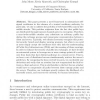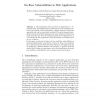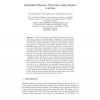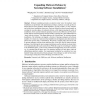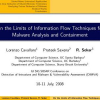99
Voted
DIMVA
2008
15 years 1 months ago
2008
Over the past several years, US-CERT advisories, as well as most critical updates from software vendors, have been due to memory corruption vulnerabilities such as buffer overflo...
103
Voted
DIMVA
2008
15 years 2 months ago
2008
Malicious software in form of Internet worms, computer viruses, and Trojan horses poses a major threat to the security of networked systems. The diversity and amount of its variant...
106
Voted
DIMVA
2008
15 years 2 months ago
2008
Abstract. This paper presents a novel framework to substantiate selfsigned certificates in the absence of a trusted certificate authority. In particular, we aim to address the prob...
83
Voted
DIMVA
2008
15 years 2 months ago
2008
Abstract A web programmer often conceives its application as a sequential entity, thus neglecting the parallel nature of the underlying execution environment. In this environment, ...
106
click to vote
DIMVA
2008
15 years 2 months ago
2008
Embedded malware is a recently discovered security threat that allows malcode to be hidden inside a benign file. It has been shown that embedded malware is not detected by commerci...
104
Voted
DIMVA
2008
15 years 2 months ago
2008
Abstract. This paper focuses on defense mechanisms for cross-site scripting attacks, the top threat on web applications today. It is believed that input validation (or filtering) c...
98
Voted
DIMVA
2008
15 years 2 months ago
2008
Software installation provides an attractive entry vector for malware: since installations are performed with administrator privileges, malware can easily get the enhanced level of...
113
Voted
DIMVA
2008
15 years 2 months ago
2008
Abstract. Stealthy malware, such as botnets and spyware, are hard to detect because their activities are subtle and do not disrupt the network, in contrast to DoS attacks and aggre...
83
Voted
DIMVA
2008
15 years 2 months ago
2008
113
click to vote
DIMVA
2008
15 years 2 months ago
2008
Botnets are large groups of compromised machines (bots) used by miscreants for the most illegal activities (e.g., sending spam emails, denial-of-service attacks, phishing and other...

